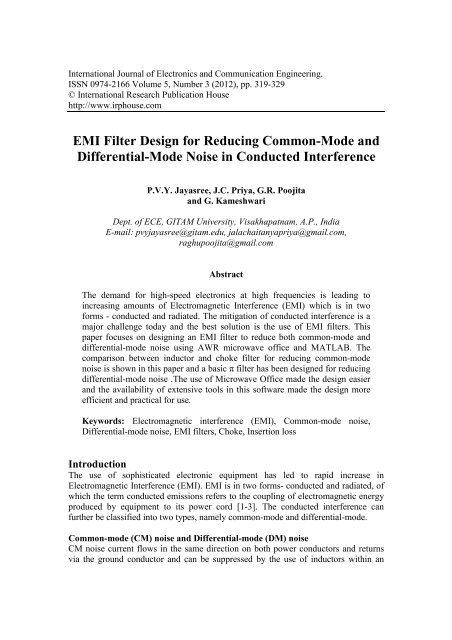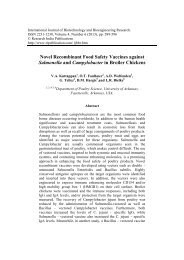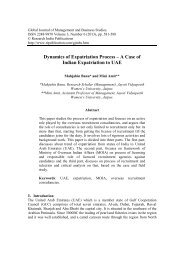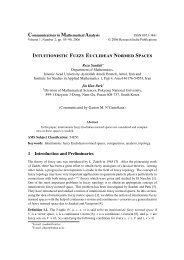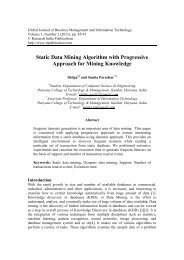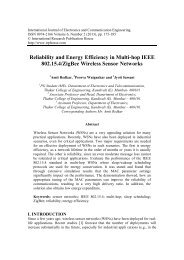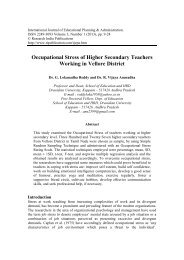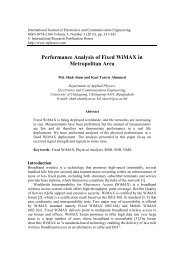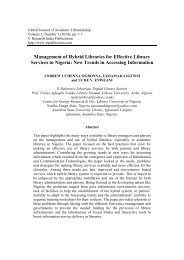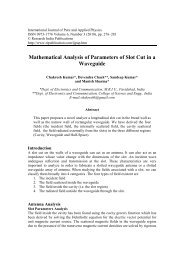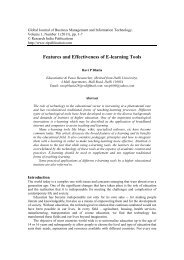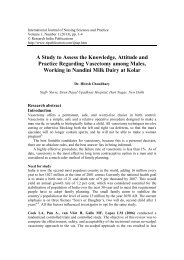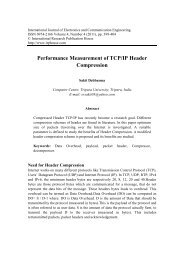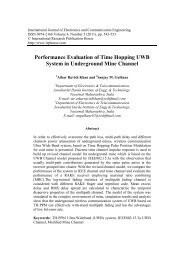EMI Filter Design for Reducing Common-Mode and Differential ...
EMI Filter Design for Reducing Common-Mode and Differential ...
EMI Filter Design for Reducing Common-Mode and Differential ...
You also want an ePaper? Increase the reach of your titles
YUMPU automatically turns print PDFs into web optimized ePapers that Google loves.
International Journal of Electronics <strong>and</strong> Communication Engineering.<br />
ISSN 0974-2166 Volume 5, Number 3 (2012), pp. 319-329<br />
© International Research Publication House<br />
http://www.irphouse.com<br />
<strong>EMI</strong> <strong>Filter</strong> <strong>Design</strong> <strong>for</strong> <strong>Reducing</strong> <strong>Common</strong>-<strong>Mode</strong> <strong>and</strong><br />
<strong>Differential</strong>-<strong>Mode</strong> Noise in Conducted Interference<br />
P.V.Y. Jayasree, J.C. Priya, G.R. Poojita<br />
<strong>and</strong> G. Kameshwari<br />
Dept. of ECE, GITAM University, Visakhapatnam, A.P., India<br />
E-mail: pvyjayasree@gitam.edu, jalachaitanyapriya@gmail.com,<br />
raghupoojita@gmail.com<br />
Abstract<br />
The dem<strong>and</strong> <strong>for</strong> high-speed electronics at high frequencies is leading to<br />
increasing amounts of Electromagnetic Interference (<strong>EMI</strong>) which is in two<br />
<strong>for</strong>ms - conducted <strong>and</strong> radiated. The mitigation of conducted interference is a<br />
major challenge today <strong>and</strong> the best solution is the use of <strong>EMI</strong> filters. This<br />
paper focuses on designing an <strong>EMI</strong> filter to reduce both common-mode <strong>and</strong><br />
differential-mode noise using AWR microwave office <strong>and</strong> MATLAB. The<br />
comparison between inductor <strong>and</strong> choke filter <strong>for</strong> reducing common-mode<br />
noise is shown in this paper <strong>and</strong> a basic π filter has been designed <strong>for</strong> reducing<br />
differential-mode noise .The use of Microwave Office made the design easier<br />
<strong>and</strong> the availability of extensive tools in this software made the design more<br />
efficient <strong>and</strong> practical <strong>for</strong> use.<br />
Keywords: Electromagnetic interference (<strong>EMI</strong>), <strong>Common</strong>-mode noise,<br />
<strong>Differential</strong>-mode noise, <strong>EMI</strong> filters, Choke, Insertion loss<br />
Introduction<br />
The use of sophisticated electronic equipment has led to rapid increase in<br />
Electromagnetic Interference (<strong>EMI</strong>). <strong>EMI</strong> is in two <strong>for</strong>ms- conducted <strong>and</strong> radiated, of<br />
which the term conducted emissions refers to the coupling of electromagnetic energy<br />
produced by equipment to its power cord [1-3]. The conducted interference can<br />
further be classified into two types, namely common-mode <strong>and</strong> differential-mode.<br />
<strong>Common</strong>-mode (CM) noise <strong>and</strong> <strong>Differential</strong>-mode (DM) noise<br />
CM noise current flows in the same direction on both power conductors <strong>and</strong> returns<br />
via the ground conductor <strong>and</strong> can be suppressed by the use of inductors within an
320<br />
P.V.Y. . Jayasree et al<br />
<strong>EMI</strong> filter that are placed in series with each power line <strong>and</strong> by Y-capacitors that are<br />
connected from both power line conductors to ground [4-6].<strong>Differential</strong> mode (DM)<br />
current flows through one<br />
ac conductor <strong>and</strong> returns along another [7-9] <strong>and</strong> can be<br />
suppressed by the filter which contains an inductor in series <strong>and</strong> X-capacitors<br />
connected in parallel between the two current carrying conductors. The CM <strong>and</strong> DM<br />
noises exist as shown in Figure1.<br />
Figure 1: <strong>Common</strong>-mode <strong>and</strong> differential-mode noise.<br />
<strong>Common</strong> mode noise is given as,<br />
V cm<br />
=<br />
V P<br />
+<br />
2<br />
V N<br />
<strong>and</strong> differential noise is given as,<br />
V P − V<br />
V dm<br />
=<br />
N<br />
2<br />
(1)<br />
(2)<br />
where, V P is phase voltage<br />
<strong>and</strong> V N is neutral voltage. The capacitors C P are connected<br />
in shunt to the power lines to reduce CM noise <strong>and</strong> in order to reduce DM noise<br />
capacitors should be connected across the power line [9].<br />
<strong>EMI</strong> <strong>Filter</strong>s<br />
<strong>EMI</strong> filtering circuits are employed so that the end product complies with the<br />
applicable EMC st<strong>and</strong>ards. Among the most frequently cited EMC<br />
st<strong>and</strong>ards are<br />
EN55022 or its equivalent CISPR 22 st<strong>and</strong>ard <strong>for</strong> IT equipment,<br />
EN55011 <strong>for</strong><br />
industrial equipment [7].<br />
Table 1: CISPR 22 Conducted Emissions Limits <strong>for</strong> Class A Devices<br />
Frequency<br />
(MHz) µV QP (AV) dB(µV) QP (AV)<br />
0.15 - 0.5 8912.5 (1995) 79 (66)<br />
0.5 - 30 4467 (1000) 73 (60)
<strong>EMI</strong> <strong>Filter</strong> <strong>Design</strong> <strong>for</strong> <strong>Reducing</strong> <strong>Common</strong>-<strong>Mode</strong> 321<br />
Table 2: CISPR 22 Conducted Emission Limits <strong>for</strong> Class B Devices<br />
Frequency (MHz) µV QP (AV) dB(µV) QP (AV)<br />
0.15 - 0.5 1995-631 (631-199.5) 66-56 (56-46) (limit varies linearly)<br />
0.5 - 5 631 (199.5) 56 (46)<br />
5 - 30 1000 (316) 60 (50)<br />
The frequency limits <strong>for</strong> conducted emissions are shown in Table 1 <strong>and</strong> Table 2<br />
[4-5]. Conducted emissions are regulated by CISPR over the frequency range from<br />
150 KHz-30MHz [10-12]. If the emissions are found to exceed the limits specified by<br />
EMC st<strong>and</strong>ards, then <strong>EMI</strong> filter would be designed in order to reduce the noise<br />
produced by the equipment under test.<br />
<strong>Filter</strong> <strong>Design</strong><br />
The basic setup shown in Figure2 consists of Line Impedance Stabilization Network<br />
(LISN), Equipment under Test (EUT) which is a 2-transistor SMPS circuit, mains<br />
power supply <strong>and</strong> a noise separator circuit<br />
Figure 2: Conducted emissions measurement setup<br />
Line Impedance Stabilization Network (LISN)<br />
The conducted <strong>EMI</strong> measurement procedure requires a 50 W/ 50 mH Line Impedance<br />
Stabilization Network (LISN) to be inserted between the equipment under test (EUT)<br />
<strong>and</strong> the ac utility line to provide specified measuring impedance <strong>for</strong> noise voltage<br />
measurement [5]. The basic schematic of LISN is shown in Figure3.
322<br />
P.V.Y. . Jayasree et al<br />
Figure 3: Schematic of LISN.<br />
Euipment Under Test (EUT)<br />
The EUT used in this setup is a 2-transistor SMPS circuit that consists of two<br />
transistors, diodes whichh act as noise sources from which conducted <strong>EMI</strong> is<br />
generated.<br />
Noise Separators<br />
The common mode <strong>and</strong> differential mode noises from the measured output are<br />
separated using a noise separator. DM noise rejection is done using a passive circuit<br />
while an active circuit is used <strong>for</strong> CM noise rejection.<br />
Basic <strong>EMI</strong> filters<br />
There are numerous <strong>EMI</strong> filters that could be considered <strong>for</strong> noise reduction, but the<br />
most popularly used are the LC inductor filter <strong>and</strong> the π filter <strong>for</strong> CM <strong>and</strong> DM noises<br />
respectively [13]. The aim<br />
is to obtain the maximum impedance mismatch between<br />
the filter <strong>and</strong> the outside system.<br />
Figure 4: Inductor filter<br />
Figure 5: π filter
<strong>EMI</strong> <strong>Filter</strong> <strong>Design</strong> <strong>for</strong> <strong>Reducing</strong> <strong>Common</strong>-<strong>Mode</strong> 323<br />
A better solution over the inductor filter is the choke filter. Chokes withst<strong>and</strong> high<br />
DC currents without degradation of filtering per<strong>for</strong>mance. Chokes reduce noise<br />
considerably over the entire desired frequency range.The components of inductor<br />
filter are designed such that<br />
If<br />
1<br />
w(2C<br />
CM<br />
> 25Ω<br />
(3)<br />
Where L CM <strong>and</strong> C CM are inductor <strong>and</strong> capacitor used in the design of inductor filter<br />
<strong>and</strong> Z P is the impedance of the euipment used [3].<br />
The components of π filter are designed such that<br />
1<br />
If >> 100 <strong>and</strong><br />
w(<br />
C DM<br />
)<br />
1<br />
w(<br />
C<br />
DM<br />
> 100Ω<br />
(4)<br />
Where L DM <strong>and</strong> C DM are inductor <strong>and</strong> capacitors used in the design of π filter <strong>and</strong><br />
Z P is the impedance of the equipment used [3].<br />
Conducted Emissions Measurements<br />
The experiment was initially conducted with the measurement setup shown in<br />
Figure2, but without filter across 150KHz-1.5MHz frequency range. The actual<br />
connected schematic has been shown in Figure6. The measured common-mode noise<br />
voltage, V cm (dB) <strong>and</strong> DM noise V dm (dB) across the noise separator, are shown in<br />
Figure7 <strong>and</strong> Figure8. Using these magnitudes, the insertion loss graphs were obtained<br />
in MATLAB. The simulation plots obtained in MATLAB showed that the V cmdBµV<br />
<strong>and</strong> V dmdBµV without filter have exceeded the V limdBµV set by the EMC st<strong>and</strong>ard <strong>for</strong><br />
Class B equipment. Hence, the basic <strong>EMI</strong> filters were designed to be placed between<br />
the LISN <strong>and</strong> EUT <strong>and</strong> the noise outputs were once again measured <strong>and</strong> graphs were<br />
simulated.
324<br />
P.V.Y. . Jayasree et al<br />
Figure 6: Conducted emissions measurement setup using AWR-Microwave Office.<br />
Figure 7: V cm (dB) measured without filter across output of noise separator.<br />
Figure 8: V dm (dB) measured without filter across output of noise separator.
<strong>EMI</strong> <strong>Filter</strong> <strong>Design</strong> <strong>for</strong> <strong>Reducing</strong> <strong>Common</strong>-<strong>Mode</strong> 325<br />
The Insertion loss without filter was calculated by,<br />
IL<br />
IL<br />
cm dBuv<br />
dm dBuv<br />
= V − V<br />
(5)<br />
cm dBuV<br />
dm dBuV<br />
lim dBuv<br />
= V − V<br />
(6)<br />
lim dBuv<br />
where, V cm is the common mode noise obtained in Microwave office whose<br />
magnitude is shown in Figure7, Vdm is the value differential mode noise obtained<br />
whose magnitude is shown in Figure8. V lim is the EMC limit <strong>for</strong> conducted emissions<br />
which is in dBμV <strong>and</strong> hence the output noise obtained is converted into dBμV by<br />
adding 120 to output noise magnitude[5]. The aim was to design the filter to reduce<br />
the CM <strong>and</strong> DM noises <strong>and</strong> hence the design needs an insertion loss greater than that<br />
given equations 5 <strong>and</strong> 6.<br />
Hence, the filter components were tuned in Microwave Office refereing to the<br />
equations 3 <strong>and</strong> 4 such that they produce noise voltages that would give an Insertion<br />
loss greater than that in equations 5 <strong>and</strong> 6. Once these components were tuned to give<br />
the required insertion loss, the same was simulated in MATLAB using the equations 7<br />
<strong>and</strong> 8 <strong>for</strong> inductor <strong>and</strong> π filter <strong>for</strong> CM <strong>and</strong> DM noises respectively. The obtained<br />
insertion losses using the filters is simulated using,<br />
IL<br />
IL<br />
cmif dBuv<br />
dmif dBuv<br />
= V − V<br />
(7)<br />
cm dBuV<br />
dm dBuV<br />
cmif dBuv<br />
= V − V<br />
(8)<br />
dmif dBuv<br />
where, V cmdBμV <strong>and</strong> V dmdBμV are values obtained without using filter <strong>and</strong> V cmif <strong>and</strong><br />
V dmif are the noise voltages obtained after tuning filter components <strong>for</strong> inductor <strong>and</strong> π<br />
filter respectively.<br />
Inductor filter<br />
The inductor filter was placed between the LISN <strong>and</strong> EUT <strong>and</strong> the filter circuit was<br />
tuned to obtain insertion loss greater than the loss obtained be<strong>for</strong>e embeding filter<br />
across the desired frequency range. The obtained CM noise voltage, V cmifdB was<br />
measured across the output of noise separator in AWR-Microwave Office. It could be<br />
observed that noise output reduced considerably by using the inductor filter.<br />
Figure9(a) shows that <strong>for</strong> frequencies from 300KHz-1.5MHz, the noise is within the<br />
limits specified by EMC st<strong>and</strong>ards. To obtain desired insertion loss below 300KHz,<br />
the choke filter was used instead of inductor filter <strong>and</strong> the results were obtained as in<br />
Figure9(b).<br />
Choke filter<br />
It shows that by using choke filter there is a tremendous reduction in noise <strong>for</strong><br />
frequencies less than 300KHz <strong>and</strong> over the entire range till 1.5MHz. The loss<br />
simulations are shown in Figure10.
326<br />
P.V.Y. . Jayasree et al<br />
.<br />
Figure 9(a): Comparision<br />
of CM Voltage with <strong>and</strong> without filter with V lim set by <strong>EMI</strong><br />
st<strong>and</strong>ards<br />
Figure 9(b): Comparision<br />
of CM voltage without filter <strong>and</strong> with choke with V lim set<br />
by <strong>EMI</strong> st<strong>and</strong>ards<br />
Figure 10: Insertion loss(dBuV) vs Frequency <strong>for</strong> inductor <strong>and</strong><br />
comparison to insertion loss without filter.<br />
choke filter in
<strong>EMI</strong> <strong>Filter</strong> <strong>Design</strong> <strong>for</strong> <strong>Reducing</strong> <strong>Common</strong>-<strong>Mode</strong><br />
327<br />
Figure 11: Comparison of DM output with <strong>and</strong> without filter with V lim set by EMC<br />
st<strong>and</strong>ards.<br />
Figure 12: Insertion loss( (dBµV) vs Frequency <strong>for</strong><br />
loss without filter.<br />
filter in comparison to insertion<br />
pi filter<br />
To reduce the differential-mode noise, the filter was placed between<br />
the LISN <strong>and</strong><br />
EUT <strong>and</strong> the filter was tuned to obtain DM noise voltage, whose<br />
insertion loss<br />
obtained is greater than the loss be<strong>for</strong>e embeding filter across the desired frequency<br />
range. The result obtained is shown in Figure11. Figure12 plots the<br />
insertion loss<br />
measurement with <strong>and</strong> without π filter<br />
Results<br />
The conducted emissions measurement setup without the filter produced an insertion<br />
loss of around 40-90dBμV<br />
<strong>for</strong> 150-300KHz frequency range <strong>and</strong> 30dBμV over the
328 P.V.Y. Jayasree et al<br />
frequency range from 300KHz-1.5MHz <strong>for</strong> common mode noise. Insertion loss of 50-<br />
100dBμV was obtained over 150KHz-300KHz <strong>and</strong> 50dBμV over 300KHz-750KHz<br />
<strong>for</strong> differential mode. The designed filters pi, inductor <strong>and</strong> choke produced an<br />
insertion loss greater than the measurement setup without a filter. The inductor filter<br />
produced insertion loss of around 40-80dBμV from 300KHz-1.5MHz range <strong>and</strong> the<br />
choke filter produced loss of around 320-550dBμV over the frequencies from<br />
150KHz-1.5MHz. The filter produced an insertion loss of 80-560dBμV <strong>for</strong><br />
150KHz-300KHz <strong>and</strong> 550-750dBμV over 300KHz-750KHz. The use of AWR-<br />
Microwave Office made it much easier to tune the <strong>EMI</strong> filter to get the required<br />
Insertion loss.<br />
Conclusion<br />
The inductor filter produced desired insertion loss <strong>for</strong> frequencies from 300KHz-<br />
1.5MHz, but the choke filter produced better results than the inductor filter <strong>and</strong> also<br />
the obtained noise reduced considerably over the entire considered frequency range<br />
from 150KHz-1.5MHz. The π filter is a good option <strong>for</strong> reducing the DM noise over<br />
the frequencies from 150KHz-750KHz. Hence, choke <strong>and</strong> pi filter are good <strong>EMI</strong><br />
solutions over the conducted emissions range of 150KHz-1.5MHz.<br />
References<br />
[1] Klaus Raggl, Thomas Nussbaumer, Johann W. Kolar “Guideline <strong>for</strong> a<br />
Simplified <strong>Differential</strong>-<strong>Mode</strong> <strong>EMI</strong> <strong>Filter</strong> <strong>Design</strong>” IEEE TRANSACTIONS ON<br />
INDUSTRIAL ELECTRONICS, VOL. 57, NO. 3 MARCH 2010.<br />
[2] P. Ram Mohan, M. Vijaya Kumar, O .V. Raghava Reddy, ”a novel topology of<br />
<strong>EMI</strong> filter to suppress common mode <strong>and</strong> differential mode noises of<br />
electromagnetic interference in switching mode power supplies”, VOL. 2, NO.<br />
4, AUGUST 2007 ISSN 1819-6608 ARPN Journal of Engineering <strong>and</strong> Applied<br />
Sciences.<br />
[3] Jukka-Pekka Sjöroos “Conducted <strong>EMI</strong> filter design <strong>for</strong> SMPS”, Helsinki<br />
University of Technology, Power Electronics Laboratory.<br />
[4] EMC Lab Info: www.emclabinfo.com.<br />
[5] Richard Lee Ozenbaugh, 2001, ’<strong>EMI</strong> <strong>Filter</strong> <strong>Design</strong>’.<br />
[6] Maria Carmela Di Piazza, Member, IEEE, Antonella Ragusa, Member, IEEE,<br />
<strong>and</strong> Gianpaolo Vitale, Member, IEEE, ”<strong>Design</strong> of Grid-Side Electromagnetic<br />
Interference <strong>Filter</strong>s in AC Motor Drives With Motor-Side <strong>Common</strong> <strong>Mode</strong><br />
Active Compensation”, IEEE TRANSACTIONS ON ELECTROMAGNETIC<br />
COMPATIBILITY, VOL. 51, NO. 3, AUGUST 2009.<br />
[7] Mel Berman, October 2008, ”All about <strong>EMI</strong> filters”, www.us.tdk-lambda.com.<br />
[8] IMPACT - module 5, ”conducted <strong>EMI</strong>/EMC”, Indian institute of technology,<br />
new Delhi<br />
[9] M. L. Heldwein, T. Nussbaumer; <strong>and</strong> J. W. Kolar, ”<strong>Differential</strong> <strong>Mode</strong> EMC<br />
Input <strong>Filter</strong> <strong>Design</strong> <strong>for</strong>Three-Phase AC-DC-AC Sparse Matrix PWM
<strong>EMI</strong> <strong>Filter</strong> <strong>Design</strong> <strong>for</strong> <strong>Reducing</strong> <strong>Common</strong>-<strong>Mode</strong> 329<br />
Converters”, Swiss Federal Institute of Technology (ETH) Zurich, Power<br />
Electronic Systems Laboratory, ETH Zentrum / ETL H23, Physikstrasse 3, CH-<br />
8092 Zurich, SWITZERLAND.<br />
[10] , ”Limits <strong>and</strong> methods of measurement”, In<strong>for</strong>mation technology equipment -<br />
Radio disturbance characteristics, 1998.<br />
[11] CISPR16 specialization <strong>for</strong> radio interference <strong>and</strong> immunity measuring<br />
apparatus <strong>and</strong> methods, Int. Electrotech. Comm., Geneva, Switzerl<strong>and</strong>, Nov.<br />
2003.<br />
[12] CISPR 22, In<strong>for</strong>mation Technology Equipment—Radio Disturbance<br />
Characteristics—Limits <strong>and</strong> Methods of Measurement, Int. Electrotech.Comm.,<br />
Nov. 1997.<br />
[13] Vuttipon Tarateeraseth, Student Member, IEEE, Kye Yak See, Senior Member,<br />
IEEE, Flavio G.Canavero, Fellow, IEEE, <strong>and</strong> Richard Weng-Yew Chang,<br />
Member, IEEE, ” Systematic Electromagnetic Interference <strong>Filter</strong> <strong>Design</strong> Based<br />
on In<strong>for</strong>mation From In-Circuit Impedance Measurements”, IEEE<br />
TRANSACTIONS ON ELECTROMAGNETIC COMPATIBILITY,<br />
VOL.52NO.3, August2010.


